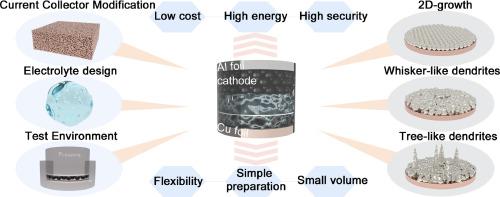The allure of spherical lithium deposition—realizing the stable cycle of anode-free lithium-metal batteries
IF 20.2
1区 材料科学
Q1 CHEMISTRY, PHYSICAL
引用次数: 0
Abstract
The deepening electrification of society and the wide application of electric vehicles have raised the demand for high-energy-density batteries. The anode-free lithium-metal battery (AFLMB), which relies on a simple internal structure of the battery to bring about high energy density, has a broad application prospect. The lack of surplus Li metal at the anode restricts the active material in AFLMB to only the cathode and electrolyte, resulting in a more concentrated distribution within the batteries. Thus, most AFLMBs encounter a rapid decline in capacity after 100 cycles, presenting a significant challenge. Maximizing the effectiveness of the limited active substances is the breakthrough to improve the cycling performance of AFLMB. Based on the latest research findings, this paper presents a comprehensive analysis of the factors for the capacity decline in the AFLMB cycling process, specifically focusing on the behavior of Li deposition on the anode. We explore the relationship between the lithophilic nature of the substrate and Li deposition morphology, along with methods for characterization, and propose optimal spherical deposition. Furthermore, it discusses strategies for optimizing Li deposition behavior through current collector modification, electrolyte modification, and improvement of test conditions. Ultimately, this evaluation of optimization strategies for Li deposition morphology aims to offer insights for advancing AFLMB development and enhancing its long-cycle stability.


球形锂沉积的魅力——实现无阳极锂金属电池的稳定循环
社会电气化程度的加深和电动汽车的广泛应用,提高了对高能量密度电池的需求。无负极锂金属电池(AFLMB)依靠简单的电池内部结构实现了高能量密度,具有广阔的应用前景。由于阳极没有多余的锂金属,AFLMB 中的活性材料只能分布在阴极和电解液中,因此在电池内部的分布更为集中。因此,大多数 AFLMB 在循环 100 次后容量会迅速下降,这给我们带来了巨大的挑战。最大限度地发挥有限活性物质的功效是提高 AFLMB 循环性能的突破口。本文在最新研究成果的基础上,全面分析了 AFLMB 循环过程中容量下降的因素,特别是阳极上锂沉积的行为。我们探讨了基底的嗜石性与锂沉积形态之间的关系以及表征方法,并提出了最佳球形沉积。此外,报告还讨论了通过修改集流器、修改电解质和改善测试条件来优化锂沉积行为的策略。最终,对锂沉积形态优化策略的评估旨在为推进 AFLMB 的开发和提高其长周期稳定性提供见解。
本文章由计算机程序翻译,如有差异,请以英文原文为准。
求助全文
约1分钟内获得全文
求助全文
来源期刊

Energy Storage Materials
Materials Science-General Materials Science
CiteScore
33.00
自引率
5.90%
发文量
652
审稿时长
27 days
期刊介绍:
Energy Storage Materials is a global interdisciplinary journal dedicated to sharing scientific and technological advancements in materials and devices for advanced energy storage and related energy conversion, such as in metal-O2 batteries. The journal features comprehensive research articles, including full papers and short communications, as well as authoritative feature articles and reviews by leading experts in the field.
Energy Storage Materials covers a wide range of topics, including the synthesis, fabrication, structure, properties, performance, and technological applications of energy storage materials. Additionally, the journal explores strategies, policies, and developments in the field of energy storage materials and devices for sustainable energy.
Published papers are selected based on their scientific and technological significance, their ability to provide valuable new knowledge, and their relevance to the international research community.
 求助内容:
求助内容: 应助结果提醒方式:
应助结果提醒方式:


